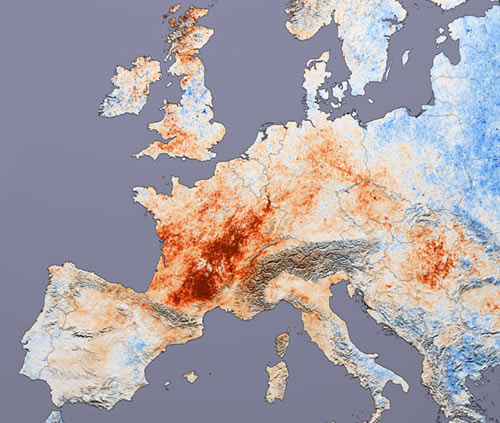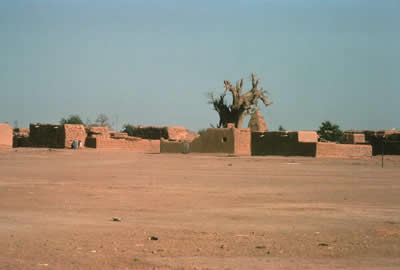Extreme Events and Human Health
As climate warms, a growing number of people will be affected by heat waves, storms and associated flooding, and droughts. Below, are descriptions of these events, information about how warming has changed each, how future warming is predicted to change each, and the risks posed to human health. It is important to remember that while the information below carries a focus of the impacts on human health, events like these have a broad range of impacts aside from human health that may include impacts on the health of other living things, coastal and soil erosion, and impacts on freshwater or shallow marine systems.
 |
This image by the Moderate Resolution Imaging Spectroradiometer (MODIS) on NASA's Terra satellite shows the extent and severity of the 2003 European heat wave. Colors indicate the differences in daytime land surface temperatures collected between July 2001 and July 2003. The red area indicates where temperatures were 10 degrees Celsius (18 degrees Fahrenheit) hotter during the summer of 2003 than the summer of 2001. White areas show where temperatures were similar, and blue show where temperatures were cooler in 2003 than 2001. |
Heat Waves
Hot daytime temperatures with little or no relief from the heat at night characterize heat wave conditions. According to the American Meteorological Society (AMS) Glossary of Meteorology, a heat wave is "a period of abnormally and uncomfortably hot and usually humid weather." The key word there is "abnormally" as heat wave temperatures can differ depending on the normal conditions for a region. For example, temperature during a heat wave in Phoenix, Arizona might reach 115 degrees Fahrenheit while London, England heat wave temperatures might reach only 90 or 95 degrees. A heat wave might last only one day or may go on for several weeks. As the Earth’s climate has warmed there have been more hot days, hot nights, and heat waves. Future predictions for the next century indicate that heat waves are very likely to become more common. According to climate model results for areas of Europe and North America, future heat waves will become more intense, more frequent, and longer lasting in the second half of the 21st century.
With a heat wave comes a short-term increase in mortality. Elderly people, people who work outside, and homeless populations are especially vulnerable during a heat wave. Deaths are usually due to heat stoke or hyperthermia – during which a person’s ability to regulate his or her temperature becomes overwhelmed and more heat is taken in than can be dissipated by sweating and pumping blood closer to the skin. Associated decreases in air quality during heat waves also negatively affect human health and can cause deaths. While heat waves might appear less dramatic than a violent storm, they can be much more deadly. According to the Earth Policy Institute, heat waves “claim more lives each year than floods, tornadoes, and hurricanes combined.”
The major heat wave in Europe during the end of July and the first half of August 2003 was likely linked to anthropogenic climate change according to the IPCC. Central France had the most extreme heat, although many areas of Western Europe were affected. Referred to in French by the informal term “canicule”, heat waves are not terribly common in France. People in France still talk about the canicule of 2003. It made a huge impact on the nation and spurred lawmakers to develop a system to warn and protect people in the event of another large heat wave. There were seven days with temperatures of more than 104 degrees Fahrenheit (40C) in Auxerre in central France during the summer of 2003. The UK recorded its first temperature over 100 degrees Fahrenheit in recorded history on August 10. The heat wave spawned massive wildfires in France, Portugal, and other countries. In terms of direct impacts on human health, dramatically higher mortality rates were reported from many European countries during the event including Belgium, Czech Republic, France, Germany, Italy, Portugal, Spain, Switzerland, the Netherlands, and the United Kingdom. In total, there were about 35,000 heat-related deaths during the event. France was particularly hard hit with the heat causing more that 14,800 deaths. Around 60% of those people were age 75 or older. In addition to the heat, other factors, such as ozone and air pollutants from wildfires spawned by the heat, also compromised human health.
The opposite of a heat wave is known as a cold wave. Cold waves are defined as a rapid fall in winter temperature that leads to a period of abnormal cold. While climate change is expected to lead to less cold wave conditions at high latitudes, this is not expected to make a large impact on human health because protections against the cold have been put in place during the latter half of the 20th century (i.e., heating systems, insulation) which greatly decrease the number of deaths from cold waves.
 |
The Midwest Flood of 1993 caused 15 billion dollars in damage and killed 50 people. Thousands of people were evacuated, some for months. Hundreds of levees along the Mississippi River failed as the flood unfolded through the summer. While the Mississippi is most likely to flood in the spring because of added water from snowmelt, it was torrential rains in June and July that triggered the full calamity. |
Storms
Storms, and the associated flooding from storms, can overwhelm infrastructure as well as people’s ability to cope. The IPCC Forth Assessment Report describes floods as, "low probability, high-impact events." That’s a technical way of saying that, while they rarely happen, they can catch people off guard and cause large amounts of hullabaloo when they do happen. It is very likely that there will be more heavy rain events as climate continues to warm. It is also likely that tropical cyclones will become more intense.
The extent of flooding due to a storm depends on the amount of rainfall, amount of surface runoff, evaporation, wind, sea level, and local topography. Coastal storm surge, which occurs with hurricanes and tropical storms, can cause significant flooding of ocean water into human settlements. As sea level continues to rise, the effects of storm surge on coastlines will become more pronounced. Floods and tropical cyclones have the greatest impact on the human populations of South Asia and Latin America. Recent extreme flood events include a 2003 flood in China which affected 130 million people, a 1999 flood in Venezuela which claimed the lives of 30,000 people, a 2000-2001 flood in Mozambique in which over 1800 people died in the flood waters and 8000 got water-borne diseases after the event.
During a flood event, the risk to human health is primarily drowning. After a flood event, risks to human health are primarily water-borne diseases and toxic contamination if flood waters compromise water and sewer systems. Depending on topography, a flood can also cause considerable risk of mudslides. In general, the risk of water-borne diseases is higher in low to moderate income countries where water and sanitation systems are less well developed. However, there is still risk in high income countries. For example, when in 2005 the flooding due to hurricanes Katrina and Rita caused sanitation systems to fail in New Orleans, LA and surrounding areas, there were increased incidence of diarrheal diseases and some deaths. Flood victims are also at risk for developing mental health problems such as anxiety and depression after the event.
 |
Sub-Saharan Africa is expected to become more drought stricken in the 21st century. This photograph of a village in Ethiopia shows evidence of the arid climate. During the 1980s, a severe famine in Ethiopia occurred when drought conditions combined with poor agricultural methods make food scarce.
|
Drought
Drought is defined as “a period of abnormally dry weather sufficiently long enough to cause a serious hydrological imbalance,” according to the AMS Glossary of Meteorology. The term drought is relative, so drought conditions in a region mean that there is significantly less precipitation relative to normal conditions. Precipitation patterns are changing in response to climate change, and they are predicted to continue to change as climate continues to warm. It is likely that more areas will be affected by drought over the next century. In general, arid parts of the world, like sub-Saharan Africa, are predicted to become more arid. As the area becomes more arid, 75-250 million people in Africa could be affected by water shortages, and agriculture could drop by half in some areas.
Various types of malnutrition affect human populations in drought conditions including undernutrition, protein-energy nutrition, micro-nutrient deficiencies. Drought conditions reduce food availability leading to undernutrition. Drought conditions can also reduce dietary diversity potentially leading to micronutrient deficiencies. The effect of drought on nutrition is amplified by HIV/AIDS according to a study in southern Africa.
Malnutrition increases the risk of both acquiring and dying from an infectious disease. The distribution of meningitis in Africa is linked to climate and drought conditions, however the causal mechanism is not fully understood. Diseases are more likely to spread from one population to another if people are migrating to less drought stricken areas, which puts populations in contact. Additionally, migration can lead to overcrowding and health impacts from lack of safe water, food, and shelter in overcrowded conditions.
The prevalence of mosquito-borne diseases is affected by drought conditions. Mosquitoes, which require water for breeding, are not well adapted to arid conditions. Reduced mosquito populations during a drought reduces the number of cases of disease, however, it also reduces the number of people who have immunity. When water returns to the area, the number of infected people grows because the population lacks immunity.
Drought conditions can lead to dust storms which are a hazard to respiratory health. Water-washed diseases become more common during droughts because the lack of available water makes washing difficult.
For more information:
- IPCC Working Group II Report on Impacts, Adaptation, and Vulnerabilities: Chapter 8-Human Health (pdf)
- Reduced greenhouse gas emissions required to avoid dangerous increases in heat stress
- More Intense, More Frequent, and Longer Lasting Heat Waves in the 21st Century
- The American Meteorological Society Glossary of Meteorology
- Frequency of Atlantic Hurricanes Doubled Over Last Century; Climate Change Suspected
- NCAR Societal Aspects of Weather: Floods
- NCAR Societal Aspects of Weather: Summer Heat and Droughts
- Earth Policy Institute
- Earth's Climate and Global Change from Windows to the Universe
The above, written by Lisa Gardiner, was designed for Understanding Climate Change Today, an online course for educators. Please visit NCAR Online Education for more information about this and other courses.






